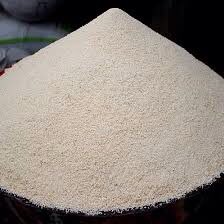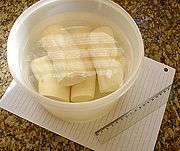
Back Gari (Afrikanische Küche) German Gali EE Garri Spanish Galí FON Gari (farine) French Gari Hausa Gari IG Garri Italian ガリ (キャッサバ) Japanese Garri JV




In West Africa, garri (also known as gari, galli, or gali) // is the flour of the fresh starchy cassava root.
In the Hausa language, garri can also refer to the flour of guinea corn, maize, rice, yam, plantain and millet.[citation needed] For example, garin dawa is processed from guinea corn, garin masara and garin alkama originate from maize and wheat respectively, while garin magani is a powdery medicine.
Starchy flours mixed with cold or boiled water form a major part of the diet in Nigeria, Benin, Togo, Ghana, Guinea, Cameroon and Liberia.[citation needed]
Cassava, the root from which garri is produced, is rich in fiber, copper and magnesium.[1]
Garri is similar to farofa of Brazil, used in many food preparations and recipes, particularly in the state of Bahia.
- ^ Nwosu, Martin (2023-08-23). "10 Amazing Health Benefits of Garri". Nccmed. Retrieved 2023-08-23.